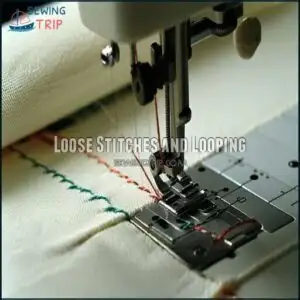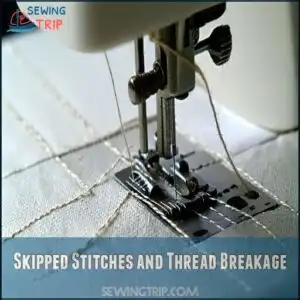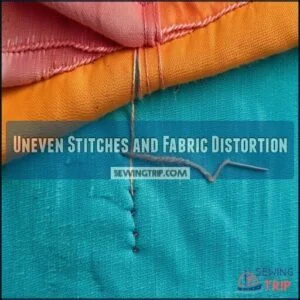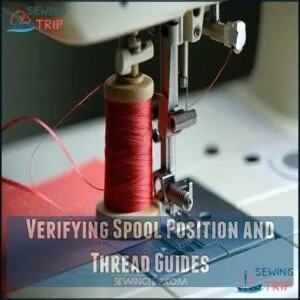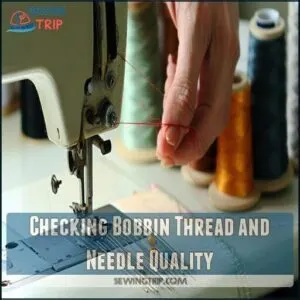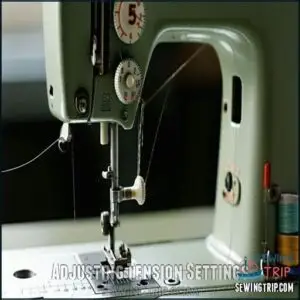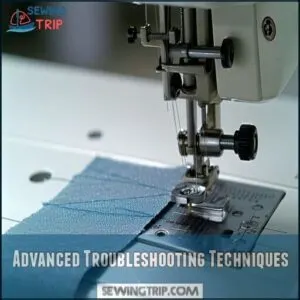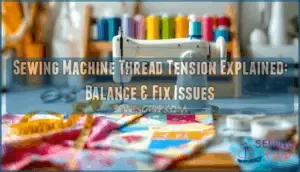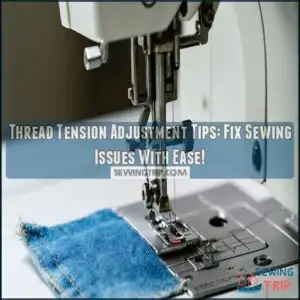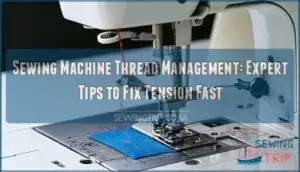This site is supported by our readers. We may earn a commission, at no cost to you, if you purchase through links.

First, double-check that your thread is sitting snugly in the thread guide and properly threaded through all the right spots. If it’s too loose, your stitches may loop or bunch up, and if it’s too tight, your fabric could pucker.
Think of it like tuning a guitar—finding that perfect balance matters! Clean out any dust bunnies hiding in the tension discs, too.
Still acting up? Adjust the tension dial in small steps. A little patience goes a long way toward sewing bliss!
Table Of Contents
Key Takeaways
- Double-check that your sewing machine is properly threaded through all guides and tension discs to prevent loose loops or tight stitches.
- Adjust the tension dial in small steps while testing on scrap fabric to achieve a balanced tension for smooth, even stitches.
- Clean your machine regularly, including the tension discs, bobbin area, and guides, to remove dust and debris that could disrupt tension.
- Match thread weight, needle size, and fabric type to minimize tension issues and avoid uneven stitching or puckering.
Thread Tension Basics
Thread tension is all about keeping the top and bobbin threads balanced so your stitches look clean and professional.
If the tension’s off, you’ll end up with loops, puckers, or worse—stitching that looks like your machine threw a tantrum!
Definition of Thread Tension
Thread tension is all about thread control—it’s how your sewing machine manages thread tautness for balanced stitches.
Think of it as a handshake between the top and bobbin threads, meeting perfectly to form each stitch.
Without proper tension mechanics, stitch formation can get messy fast.
Mastering thread tension balance keeps stitches smooth, seams flat, and frustration at bay!
Importance of Balanced Tension
Balanced tension is key to sewing like a pro.
When your sewing machine tension is just right, stitch quality improves, seams hold strong, and fabric lies smooth without puckering.
Perfect tension means flawless stitches, strong seams, and smooth fabrics—bringing your sewing projects to life with a professional finish.
It’s kind of like finding harmony—thread tension balance guarantees both sides appear flawless, giving your projects that professional finish.
Skip it, and you’ll battle uneven seams or loose loops, which can ruin the overall look and make your project appear less than professional.
Causes of Unbalanced Tension
Poor thread quality or mismatched needle size can mess up sewing machine tension, creating thread tension problems.
Incorrect machine threading or bobbin issues, like damaged cases or improper seating, also disrupt balance. A tension spring that’s too tight or loose makes matters worse.
Regular machine cleaning helps prevent persistent tension issues.
And skipping steps with your thread guide? That’s like expecting a puzzle to fit without all the pieces, and it can lead to persistent tension issues due to poor maintenance, which is why regular machine cleaning is essential.
Effects of Unbalanced Tension on Fabric
When sewing machine tension goes haywire, your fabric doesn’t stand a chance.
Here’s what can happen:
- Puckering Explained: Tension mismatches cause bunched-up seams.
- Seam Distortion: Uneven tension warps fabric edges.
- Fabric Stress: Tight stitches pull fabrics too hard.
- Stitch Integrity: Loose threads unravel your work.
- Aesthetic Impact: Uneven stitches ruin the finished look.
Mastering thread tension problems avoids these!
Common Tension Issues
Tension problems can show up as tight stitches, loose loops, or uneven seams, and they’re frustrating enough to make you want to scream at your sewing machine.
Don’t worry, though—once you spot the symptoms, fixing them is easier than you think, and it’s all about addressing the tension problems.
Tight Stitches and Puckering
When your fabric puckers like it’s having a bad day, tight stitches are often the culprit.
Causes include high sewing machine tension or incorrect threading.
Use this quick tension adjustment guide to fix it:
| Symptom | Prevention Tip | Correction Tip |
|---|---|---|
| Fabric puckers | Use quality thread | Lower the tension dial |
| Tight stitches | Match thread weight | Check needle and thread guides |
| Uneven texture | Test stitch on scrap fabric | Adjust tension gradually |
Avoid fabric damage and long-term effects by checking tension often!
Loose Stitches and Looping
Loose loops driving you loopy? It’s likely thread tension issues.
Check your Bobbin Threading first—make sure it’s smooth and snug. Next, inspect the Needle Size and Thread Quality.
Mismatched types can cause looping stitches. Run the thread through all Tension Discs and guides properly.
Test on scrap fabric; a little tension troubleshooting works wonders!
Skipped Stitches and Thread Breakage
Skipped stitches or thread breakage can make you want to toss your project out the window! They usually stem from sewing machine tension, threading errors, or bobbin issues.
Here’s the fix:
- Match needle size to thread quality—small needles can’t handle thick threads.
- Double-check the thread guide path for twists.
- Inspect the tension spring for damage.
Regular cleaning helps prevent sewing machine issues, which can lead to skipped stitches and make your project more difficult to complete, ultimately causing frustration and potentially leading to a project failure.
Uneven Stitches and Fabric Distortion
Ever notice uneven stitches or weird fabric puckering ruining your work?
It’s often about your sewing machine tension. Double-check your presser foot is down and your thread guide isn’t slipping.
Stitch length and fabric feed matter too—too fast, and chaos happens!
Match thread weight and needle type to your fabric, and watch those uneven stitches disappear like magic.
Initial Checks and Maintenance
Let’s start with the basics—sometimes tension problems just need a quick check of your machine.
A little cleaning and making sure everything’s threaded right can save you a ton of frustration (and maybe a few gray hairs).
Verifying Spool Position and Thread Guides
Check that your spool’s unwinding is smooth—over the top and in the direction of the back.
Sticky spool stickers? Peel them off! Thread guides should have perfect threading, not a single loop skipped.
Keep the presser foot raised when threading to engage those tension discs. Also, don’t let the thread snag on the bobbin winder.
Smooth thread delivery equals perfect stitches! Ensure that all parts are properly aligned to achieve this goal, and remember, smooth operation is key to successful sewing, which relies on perfect coordination of machine parts.
Checking Bobbin Thread and Needle Quality
Before stitching, double-check your bobbin thread type and make sure it matches your top thread weight to avoid bobbin tension problems.
Use a needle size guide to choose the right needle, and inspect for needle quality signs like bends or dullness.
A damaged bobbin can cause thread breakage and poor stitch quality—don’t ignore these sneaky culprits! Many sewing enthusiasts buy replacement bobbin thread to keep their machines running smoothly.
Regular Machine Cleaning and Maintenance
Sewing machine maintenance is key to smooth stitching.
Regular sewing machine cleaning, like bobbin race cleaning, prevents buildup messing with tension.
Don’t ignore thread guide care—dust loves to hide there!
Needle plate maintenance and feed dog cleaning keep fabrics gliding effortlessly.
Give your motor a once-over too.
Regular maintenance requires a specialized bobbin cleaner.
A clean machine stops thread guide issues before they even start!
Importance of Good Posture and Mindset
Once your sewing machine is clean, focus on you. Slouching or stiff shoulders mess with body alignment, causing tension issues. Stay comfy!
Mindful sewing boosts mental focus and smooths out the process.
Try these:
- Sit up straight with relaxed shoulders.
- Keep the machine at eye level for better ergonomics.
- Take breaks to reduce stress and reset.
Adjusting Tension Settings
Adjusting thread tension might sound tricky, but it’s easier than you think.
With small tweaks to the tension dial, you can fix uneven stitches and start sewing like a pro in no time.
Setting Default Tension Dial
Before adjusting thread tension, set your tension dial to its factory settings.
Your sewing machine manual is your best friend here—find the default starting point it recommends.
Use test fabric to see how the stitches look.
Factory settings often work, and if not, it gives you a baseline.
Start here before making incremental changes.
Simple, right? This approach is simple, and following these steps will help you adjust your thread tension effectively.
Incremental Tension Adjustments
Start with fabric scrap testing to see how the sewing machine tension behaves.
Small dial changes are your best friend—turn the tension dial one number at a time.
Thread weight impact? Heavier threads need looser tension.
Don’t skip documenting adjustments; it keeps things predictable.
If balancing still feels tricky, minor bobbins case tweaks might do the trick, and remember small dial changes are key.
Troubleshooting Common Tension Issues
If your sewing machine tension‘s acting up, don’t panic—troubleshoot smartly. Here’s how:
- Spot looping thread or skipped stitches? Check threading and re-thread carefully.
- Uneven stitches or fabric puckering? Adjust tension dial gradually.
- Thread snapping or breakage? Confirm needle and thread quality.
- Persistent tension issues? Clean your machine; dust loves causing trouble.
Ensure you understand adjusting tension dials for smooth sewing.
Solving thread tension doesn’t have to unravel you! It’s about being proactive.
Advanced Troubleshooting Techniques
When tension issues refuse to budge, it’s time to roll up your sleeves and get technical.
Don’t worry—you won’t need a toolbox, just some patience and a few smart tricks to keep your stitches looking sharp.
Adjusting Bobbin Case Tension
Think of the bobbin tension screw like a clock—small, 15-minute turns fine-tune thread tension.
Tighten clockwise or loosen counterclockwise, testing after adjustments. Watch for tension spring burrs to avoid stitching headaches.
Always note the bobbin screw angle before changes. Correct bobbin threading techniques are essential for avoiding these issues.
If tension issues persist, consider professional bobbin service to prevent bobbin case damage or other costly repairs.
Identifying and Fixing Thread Guide Issues
Sometimes, the tiniest thing—like lint—can mess up your thread path.
Check for guide obstructions or misaligned guides causing tension issues.
Verify the thread smoothly flows through the tension discs and spring tension isn’t too tight.
A misstep here can mean skipped stitches or thread breakage.
Consider a thread guide replacement if wear is evident.
Stay patient—sewing thread tension fixes often feel like solving a mystery!
Professional Servicing and Repair Options
If tension troubles have you pulling your hair out, it’s time to explore professional help.
Certified technicians can fine-tune your machine, often faster than you’d think. Here’s what to expect:
- Service cost varies by issue but is worth it for peace of mind.
- Quick repair timelines are typical for tension fixes.
- Check if warranty coverage applies.
- Routine machine maintenance prevents future problems.
- Professional sewing machine repair guarantees lasting precision.
Frequently Asked Questions (FAQs)
How does temperature affect thread tension stability?
Extreme heat or cold can mess with thread tension by making the thread shrink, stretch, or behave unpredictably.
It’s like a bad hair day for your thread, so aim for consistent room temperature when sewing.
What role does thread fiber play in tension?
Your thread’s fiber matters—natural fibers like cotton need lower tension, while slippery synthetics like polyester often need tighter settings.
Mixing fibers? Test first! A quick test stitch avoids drama and wasted fabric.
Can humidity impact thread tension performance?
Did you know high humidity can weaken thread fibers by up to 10%?
It’s like your thread gets droopy in the heat.
Keep threads dry and stored properly to dodge tension headaches!
How to manage tension with metallic threads?
Metallic threads can be tricky!
Lower the top tension slightly, use a metallic needle, and try a smooth-winding spool holder.
Slow stitching helps too—think of it like driving carefully on an icy road.
Are there ideal tension settings for stretchy fabrics?
Stretchy fabrics can be tricky, like baking a soufflé—too tight, and it puckers; too loose, it’s a mess.
Start with a lower tension setting (around 2-3), adjust gradually, and test on scraps.
Conclusion
Did you know that improper tension causes 80% of sewing mishaps?
Don’t let thread guide tension issues ruin your project! Take a deep breath, check your threading path, and give your tension dial those gentle tweaks.
Keep your machine clean and thread positioned just right—simple fixes can save hours of frustration.
Sewing’s like a dance between fabric and machine, so practice, adjust, and enjoy the rhythm.
You’ve got this—stitching bliss is just a thread away!
- https://www.thesewingdirectory.co.uk/thread-tension/
- https://www.youtube.com/watch?v=zh4PyWBKvwk&pp=0gcJCfcAhR29_xXO
- https://www.fortheloveofthread.com/blog/solving-tension-issues-on-your-sewing-machine
- http://ohyoucraftygal.blogspot.com/2013/10/sewing-lesson-10-how-to-fix-tension-on.html
- https://www.reddit.com/r/myog/comments/115m5wu/thread_tension_issues/



